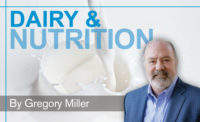Dairy powers healthy innovations

Think about your favorite food or beverage — what makes you crave it? Is it refreshing, satisfying or nourishing, or does it enhance your day or lifestyle needs? We want Americans to crave foods that are good for them, because they taste great and meet their needs. Dairy foods are a part of the answer, if we can think differently about how milk and milk products can be a solution for consumer needs.
We must do a better job providing dairy foods and beverages that are exciting, portable, convenient, nutritious and tasty. We need to design them to meet specific need-states such as healthy aging, sports performance, family-friendly, meal solutions for weight management and more. While dairy foods offer many essential nutrients, when asked, people typically list only calcium and vitamin D for milk. We need to harness the potential of dairy’s total nutrient package, using the high-quality protein found in dairy foods (i.e., milk, cheese, yogurt) as the catalyst to capitalize on the many benefits consumers want.
The work of the National Dairy Council and the Innovation Center for U.S. Dairy, both established under the leadership of America’s dairy farmers through the dairy checkoff, reflects the dairy industry’s commitment to discovering new products and educating people how to use them to satisfy their needs.
A growing consumer trend is the desire for more knowledge, not only about the nutrition and health benefits of foods, but also where their food comes from and how it is made. Many are turning away from complicated ingredients; they want real, simple and fresh foods.
In the past two years, protein content has been one of the fastest-growing claims in the food and beverage market. However, most people don’t recognize dairy foods such as milk, cheese or yogurt as a protein source.
Dairy is more than calcium
Dairy foods’ inherently nutrient-rich package is an important source of nutrients for Americans. About one-half of the calcium, one-fifth of the protein and significant amounts of several other essential nutrients come from dairy foods alone, and at only 10% of total daily calorie intake.
Although average protein consumption in the U.S. diet meets minimum requirements, research indicates there can be benefits to increasing protein intake while staying within calorie needs. This may be particularly important for older adults given the conundrum that protein intake declines with age while muscle does too, a body tissue that thrives on protein. Active individuals — from your average gym-goer to elite athletes — also could benefit from consuming more protein as part of a weight management plan or recovery from an intense workout.
There is also evidence that greater consumption of milk and milk products may be associated with lower risk for some chronic diseases. As noted in the 2010 Dietary Guidelines for Americans, moderate evidence indicates that intake of milk and milk products is linked to improved bone health, especially in children and adolescents, and is associated with a reduced risk of cardiovascular disease and type 2 diabetes and with lower blood pressure in adults.
Opportunities for innovation
Protein consumption throughout the day is uneven, with the least protein consumed at breakfast and snack occasions, and the most at dinner. Some experts suggest that spreading protein more evenly throughout the day may optimize how the body uses protein and may be more beneficial than consuming one high-protein meal. Because getting more protein at breakfast and snacks could also help achieve a higher-protein diet, this could help enhance satiety, slow age-related muscle loss and help in weight management. This provides new opportunities for dairy foods, beverages and ingredients at multiple day parts, for multiple needs.
There are untapped opportunities for our industry to innovate on the nutrient package of milk and milk products, with protein as a driver. Labeling and marketing claims can help consumers recognize how dairy foods and ingredients can help them achieve their personal goals.
It is up to us to bring this to life in a science-based, benefit-oriented way through product offerings and communications. Find out more at usdairy.com.
Why, when and where to use dairy protein
- Nutrition: A high-quality, complete protein in a nutrient-rich package.
- Flavor and texture: Offers functionalities such as natural ability to foam, gel or emulsify.
- Stability: Use it in ready-to-drink beverages when improved heat stability is desired.
- Beverages: Adds protein to many beverages that are low in nutrient density.
- Bar and bakery applications: Adds protein with minimal changes to functionality.
Looking for a reprint of this article?
From high-res PDFs to custom plaques, order your copy today!






